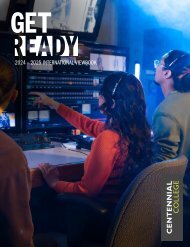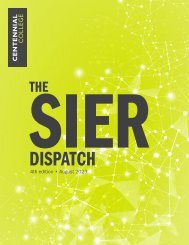SELS Dialogues Journal Volume 3 Issue 1
A diverse collection of articles, each offering a unique perspective and contributing to the ever-expanding landscape of knowledge and creativity.
A diverse collection of articles, each offering a unique perspective and contributing to the ever-expanding landscape of knowledge and creativity.
You also want an ePaper? Increase the reach of your titles
YUMPU automatically turns print PDFs into web optimized ePapers that Google loves.
Educational Technology<br />
What is AI<br />
by Tinghan Li and Dr. Richard Williamson<br />
ChatGPT, Siri, Alexa, Tesla autopilot. These words<br />
are now commonplace, and even kids know what<br />
they are. We know these programs as AI, or artificial<br />
intelligence. Ever since ChatGPT was released, the<br />
world has been abuzz about AI and what it could mean<br />
for our future. However, it has also resulted in the<br />
term “AI” being thrown around rather loosely. While<br />
modern chatbots and assistants are most definitely AI,<br />
there are many other things that would be considered<br />
artificial intelligence such as a program that creates a<br />
line of best fit on a cartesian plane. This will come as a<br />
surprise to most as anyone that has worked with graphs<br />
or spreadsheets will tell you this is one of the most<br />
basic of functions. My goal is to clear up some common<br />
misconceptions and to provide a formal definition of AI<br />
and machine learning.<br />
Let us start with a clear definition of the word<br />
“intelligence” itself. The Oxford dictionary states that<br />
intelligence means “something that is able to vary its<br />
state or action in response to varying situations, varying<br />
requirements, and past experience”. This encompasses<br />
humans, animals, and now, programs like ChatGPT.<br />
However, while we often think of smart and intelligent<br />
programs, AI includes much more than that. Artificial<br />
intelligence is what it sounds like, anything that can<br />
simulate intelligence is considered AI. In other words, it<br />
can perform the basic human functions of recognizing,<br />
predicting, and/or deciding. A simple example of AI<br />
would be old programs that identified whether or not a<br />
message was offensive. It would search for curse words,<br />
negative language, or common phrases that indicated<br />
anger or disrespect. These followed a set of rules, and<br />
were only as good as the programmer that made them.<br />
They also had no way to “learn” from the messages that<br />
they saw previously, and no way of understanding jokes,<br />
or slangs unless it was coded into them.<br />
A subset of AI is machine learning. This is where you<br />
will find the majority of the AI that we now interact with<br />
day to day. Machine learning is AI that can be trained<br />
on data, and then used to complete certain tasks. For<br />
example, YouTube’s recommendation algorithm learns<br />
from content you watched to make more accurate<br />
predictions about what you want to watch. At first it just<br />
guesses, or recommends what is popular. However, as it<br />
gets to know you, it gets better and better. One way the<br />
machine learning AIs do this is with a neural network.<br />
Think of it as a digital imitation of our brains. The<br />
neurons in our brain get stronger through using them<br />
more.. So, if you practice hockey often, your brain will<br />
strengthen neurons that relate to hockey. The neurons<br />
that relate to fine motor skills involved will likely also be<br />
strengthened so you can shoot the puck, or skate better.<br />
<strong>SELS</strong> DIALOGUES | 6















